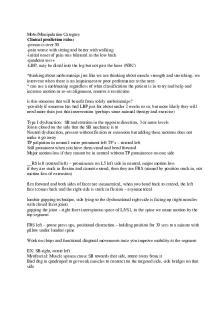Lecture notes, lecture: Group Cohesion PDF

| Title | Lecture notes, lecture: Group Cohesion |
|---|---|
| Course | Kinesiology 1088A |
| Institution | The University of Western Ontario |
| Pages | 2 |
| File Size | 69.3 KB |
| File Type | |
| Total Downloads | 98 |
| Total Views | 123 |
Summary
Download Lecture notes, lecture: Group Cohesion PDF
Description
Group Cohesion -
unity
Definition 1 – the result of all forces acting on members to remain in the group (Festinger) Definition 2 – resistance of the group to disruptive forces (Gross & Martin) Dynamic process reflected in the tendency for a group to attract members, stick together, and remain united in the pursuit of its goals and/or the satisfaction of its members (2 dimensions: TASK AND SOCIAL) (Carron) Fundamental Characteristics: 1. 2. 3. 4.
Multidimensional – numerous factors cause groups to stick together Dynamic – can change over time Instrumental – groups stick together for task purposes (to achieve common goals and objectives Affective – groups stick together because members like/enjoy each others company (social attraction)
Conceptual Model of Cohesion Environmental, Personal, Team, Leadership Cohesion Group outcomes and Individual outcomes Environmental/Situational Factors: -
Contractual, eligibility, transfer, geographical boundaries Normative/social pressures on a quitter Organization orientation (goals, strategies, maturity, sex, age, etc.) Group Size – moderately sized groups are the best from both a task and social perspective Geography (physical and functional proximity)
Personal Factors: -
Variable (demographics, cognitions, behaviours) Similarity (shared attributes – personality, sex, background) Shared attitudes and motives Adherence, social loafing, sacrifice Satisfaction with both task and social aspects (most important personal factor) Circular relation between cohesion, satisfaction, and performance
Leadership Factors: -
Task oriented behaviours (clarifying group goals and member roles) Communication (feedback, reinforcement, rewards, appreciation)
-
Decision making style Coach/athlete compatibility
Team factors: -
Performance success over a long period (generally produces cohesion) Shared experience, especially negative (failure, threats, frustration) Team stability (norms, roles, acceptance, status, satisfaction) Collective efficacy
Consequences (cohesion and what it produces) Group outcomes: -
Improved performance, communication, interaction Group stability, group satisfaction o Group goal setting Concern over self-deception by group (too cocky)
Individual outcomes: -
Improved personal states Increased role clarity/ acceptance Group goal acceptance/ conformity o Increased individual satisfaction Shared attribution of responsibility for bad outcomes...
Similar Free PDFs

Group Theory Lecture Notes
- 177 Pages

Group Cohesion AND Development
- 9 Pages

Group dynamics and Team Cohesion
- 9 Pages

Group 1 - Lecture notes 1-3
- 4 Pages

Large Group 3 - Lecture notes 3
- 2 Pages

Cohesion
- 7 Pages
Popular Institutions
- Tinajero National High School - Annex
- Politeknik Caltex Riau
- Yokohama City University
- SGT University
- University of Al-Qadisiyah
- Divine Word College of Vigan
- Techniek College Rotterdam
- Universidade de Santiago
- Universiti Teknologi MARA Cawangan Johor Kampus Pasir Gudang
- Poltekkes Kemenkes Yogyakarta
- Baguio City National High School
- Colegio san marcos
- preparatoria uno
- Centro de Bachillerato Tecnológico Industrial y de Servicios No. 107
- Dalian Maritime University
- Quang Trung Secondary School
- Colegio Tecnológico en Informática
- Corporación Regional de Educación Superior
- Grupo CEDVA
- Dar Al Uloom University
- Centro de Estudios Preuniversitarios de la Universidad Nacional de Ingeniería
- 上智大学
- Aakash International School, Nuna Majara
- San Felipe Neri Catholic School
- Kang Chiao International School - New Taipei City
- Misamis Occidental National High School
- Institución Educativa Escuela Normal Juan Ladrilleros
- Kolehiyo ng Pantukan
- Batanes State College
- Instituto Continental
- Sekolah Menengah Kejuruan Kesehatan Kaltara (Tarakan)
- Colegio de La Inmaculada Concepcion - Cebu









